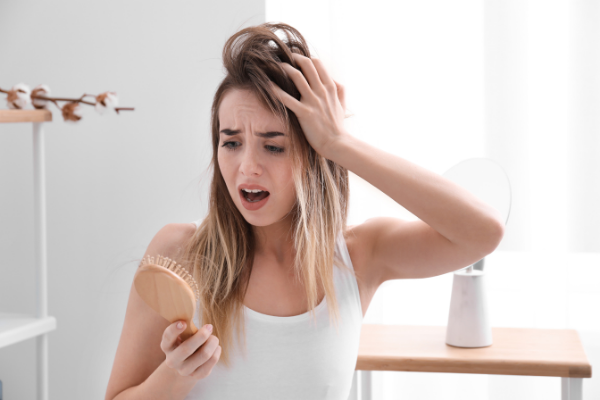
If you’ve recently given birth and have noticed your hair is starting to fall out, don’t freak out! It’s called postpartum hair loss and it typically starts 3 to 4 months after you’ve given birth. Although it can be shocking to see clumps of hair falling out of your head, postpartum hair loss is very normal and we’ve rounded up postpartum hair loss tips and treatments to help you through this trying time.
What is Postpartum Hair Loss?
Postpartum hair loss, technically called telogen effluvium, is excessive hair shedding new moms can experience after pregnancy. It usually starts 3 to 4 months after giving birth and you’ll typically notice a sudden shedding of your hair, sometimes in clumps. Hair might fall out around your head or clumps may fall loose when you brush it or shower. Everyone sheds hair on a daily basis, but during pregnancy, high hormone levels actually prevent your hair from falling out and once they’ve returned to normal after pregnancy, your hair needs to make up for lost time.
What Causes Postpartum Hair Loss?
Postpartum hair loss is all due to hormones. During pregnancy, your estrogen levels rise, which prevents your usual rate of hair loss. Typically, your hair falls out in small amounts every day but during pregnancy, your hair loss decreases. You’re also experiencing increased blood volume and circulation during this time, which also causes your hair to fall out less than normal.
Once you’ve given birth, your hormone levels drop back to normal and your hair makes up for lost time. It falls out in much bigger chunks than you’re used to and it seems overwhelming because it’s all happening at once. Rest easy though, because the total volume of hair loss likely isn’t much more than you would have lost in the past 9 months.
How Long Does Postpartum Hair Loss Last?
The good news about postpartum hair loss is that the shedding is temporary and won’t last forever. Most people that experience postpartum hair loss see their hair return to its normal fullness about 6 months to a year after giving birth. If you notice consistent shedding 15 months postpartum, you may want to seek professional help from a dermatologist.
8 Postpartum Hair Loss Tips and Treatments
1. Eat a Healthy, Balanced Diet
It’s important your body is getting the proper nutrients it needs after pregnancy for many reasons, including postpartum hair loss. Consuming a variety of fruits, vegetables and healthy proteins is key to maintaining optimal health. Foods that can improve hair health are dark leafy greens for the iron, sweet potatoes and carrots for betacarotene, eggs for vitamin D and fish for omega-3s and magnesium.
2. Be Gentle With Your Hair
Go super easy on your hair to prevent extra hair loss after pregnancy. Shampoo only when you absolutely need to, use a good conditioner and a wide-toothed comb to minimize tangling. Skip the blow dryer, curling irons and straighteners if you can and take a break from any chemically-based treatments like hair dye, highlights and perms.
3. Take Your Vitamins
Continue to take your prenatal vitamin supplement after you’ve given birth. Prenatals are packed with folic acid, a B vitamin that’s responsible for healthy cell growth, which includes skin, hair and nails. You should look for prenatals that are rich in biotin as well, which is credited for helping you grow longer, thicker hair.
4. Use a Hair Oil
This biotin serum helps to strengthen and thicken your hair by stimulating follicles and fighting hair loss at the source. It contains a blend of botanical extracts and biotin oil to protect your hair and stimulate stronger hair follicles. Apply a few drops to wet hair and massage or comb it through. It works best when left on overnight and along with encouraging growth, it also leads to less breakage.
5. Try a New Haircut
There are certain haircuts that can make your hair look fuller and more voluminous, and help new hair regrowth blend in. Shorter haircuts work well if you’re trying to hide hair loss. They won’t weigh your hair down as much and give the illusion of more volume. A long bob is a good length and bangs will cover up any new hairline recessions.
6. Use the Right Products
Use thickening shampoos and lightweight conditioners that won’t weigh your hair down. Hair is more fragile when it’s wet so make sure to brush it gently with a wide-tooth comb or wait until it’s dry. Use a microfibre towel to try it as it’s less damaging to your hair. Dry shampoo works wonders for adding volume and texture to your hair too.
7. Try a Hair Vitamin
Baby Blues Hair Vitamins contain biotin, collagen and folate to help with postpartum hair growth. The vitamins work to replenish key vitamins and minerals to help prevent and stop hair loss while accelerating new growth. They’re water soluble and easy on your stomach and are gluten and soy free. Consult a physician before use if you’re nursing or have any other medical conditions.
8. Do a Hair Mask
Ouai’s Thick Hair Hair Mask deeply moisturizes, repairs and restores your strands, which can help with growth. Made with almond, macadamia, and olive oils as well as shea butter and hydrolyzed keratin, it will leave your hair feeling smoother and stronger. Use this mask once a week to nourish your scalp and make your hair shine.
There’s nothing to like about postpartum hair loss, but at least you can rest easy knowing you’re not alone and it’s only temporary. We hope our tips and treatments help you get your gorgeous hair back as soon as possible.














































